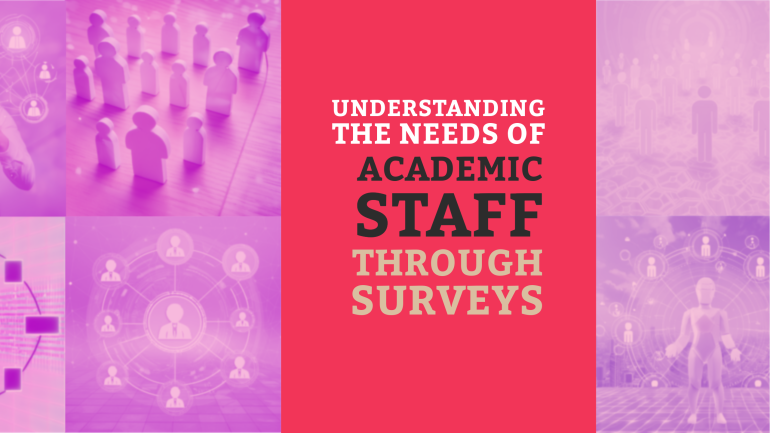Table of Contents
TL;DR: Understanding the Needs of Academic Staff through Surveys
- Survey Design: It is crucial to carefully design surveys for academic staff to gather relevant and actionable feedback.
- Specific Questions: Tailoring questions to address the unique needs and challenges of academic staff can yield more insightful responses.
- Regular Feedback: Conducting surveys periodically allows for continuous monitoring of the evolving needs of academic staff.
- Actionable Insights: Analyzing survey data to identify trends and patterns helps in implementing targeted interventions and support systems.
- Communication of Results: Sharing survey findings with academic staff fosters transparency and demonstrates a commitment to addressing their needs.
Surveys are powerful tools for gathering valuable insights from academic staff to improve institutional processes and foster a supportive work environment. By understanding the needs of academic staff through comprehensive surveys, institutions can identify key areas for enhancement, prevent potential issues, and enhance overall job satisfaction. This blog post investigates into the importance of conducting surveys among academic staff, the advantages of gathering their feedback, and how institutions can utilize this data to create a more thriving and harmonious academic community.
Designing Effective Surveys for Academic Staff
Defining Clear Objectives
Some of the most crucial aspects of designing an effective survey for academic staff involve clearly defining the objectives of the survey. Before jumping into creating questions, it is crucial to outline what you hope to achieve with the survey. This will guide the overall design and structure of the survey, ensuring that it serves its purpose effectively.
Crafting Relevant and Engaging Questions
To craft relevant and engaging questions for your survey, it is important to focus on the specific information you are seeking to gather from academic staff members. By tailoring questions to address key areas of interest or concern, you can ensure that the data collected will be valuable and actionable.
Effective survey questions are clear, concise, and directly related to the objectives of the survey. Avoid vague or ambiguous language that could lead to misunderstandings or skewed responses. Engaging questions are those that spark interest and encourage participants to provide thoughtful and honest feedback. By including a mix of closed-ended and open-ended questions, you can prompt detailed responses while also allowing for quick data analysis.
Implementation Strategies for Surveys
Selecting the Appropriate Audience
If you want your survey to yield meaningful results, selecting the right audience is crucial. Ensure that the participants are directly involved in the academic processes being evaluated, such as teaching or research activities. This targeted approach will help in gathering relevant and valuable feedback.
Ensuring Honest and Useful Feedback
Appropriate measures must be in place to encourage honesty and usefulness in the feedback received. Guaranteeing anonymity to participants can promote candid responses. Additionally, emphasizing the importance of their feedback in improving academic processes can motivate respondents to provide valuable insights.
Plus, providing a mix of open-ended and close-ended questions can offer a balance between detailed qualitative feedback and quantitative data. Ensuring clarity in the survey questions and using a variety of question types can facilitate better understanding and more comprehensive responses.
Analyzing Survey Responses
Qualitative versus Quantitative Analysis
For a comprehensive understanding of academic staff needs, analyzing survey responses requires a balance between qualitative and quantitative analysis. Quantitative data provides numerical insights, such as percentages and averages, allowing for statistical comparisons and trends identification. Qualitative data, on the other hand, gives in-depth understanding through open-ended responses, revealing nuances and contextual information that numbers alone cannot capture.
Interpreting Data for Actionable Insights
With a plethora of survey data at hand, interpreting the responses is crucial to extract actionable insights. One approach is to segment the data based on themes or categories to identify recurring issues or patterns. This process facilitates pinpointing areas that require immediate attention and helps in formulating targeted strategies to address identified needs.
To ensure that the analysis leads to actionable insights, it is vital to involve stakeholders in the interpretation process. Presenting the findings in a clear and concise manner, highlighting the most important and relevant details, can empower decision-makers to take strategic actions based on the survey results.
Addressing the Findings
Transforming Feedback into Policy Changes
Now, as we probe into addressing the findings from surveys conducted with academic staff, it is crucial to transform the feedback received into concrete policy changes. Academic institutions must carefully analyze the feedback provided by their staff and use it to shape policies that address the identified needs and concerns.
Continuous Improvement Through Regular Assessment
Feedback is the cornerstone of continuous improvement in academic settings. Regular assessment through surveys and feedback mechanisms allows institutions to track progress, identify areas for improvement, and adapt policies accordingly. By incorporating feedback loops into the organizational culture, academic institutions can foster an environment of growth and development.
Assessment not only provides insights into the current state of affairs but also serves as a roadmap for future initiatives. It is imperative that institutions prioritize continuous assessment and feedback collection to ensure they are meeting the evolving needs of academic staff. By making data-driven decisions based on feedback, institutions can demonstrate a commitment to staff well-being and professional growth.
To wrap up
Following this exploration of understanding the needs of academic staff through surveys, it is evident that in order to effectively support faculty members, institutions must prioritize gathering their feedback and insight. Surveys serve as a valuable tool to identify areas of improvement, address concerns, and ultimately create a better working environment for academic staff. By listening to the voices of faculty members and taking action based on their feedback, universities can cultivate a culture of support and collaboration that benefits both the staff and the institution as a whole.
FAQ
Q: Why is understanding the needs of academic staff important?
A: Understanding the needs of academic staff is crucial for creating a supportive and productive work environment. It allows institutions to address concerns, improve job satisfaction, and ultimately enhance teaching and research quality.
Q: How can surveys help in understanding the needs of academic staff?
A: Surveys serve as valuable tools for gathering feedback from academic staff regarding various aspects of their roles. They provide insights into areas such as workload, professional development needs, work-life balance, and overall job satisfaction.
Q: What are some key questions that should be included in surveys for academic staff?
A: Key survey questions for academic staff may cover topics such as workload distribution, access to resources, support from supervisors, opportunities for career advancement, work environment satisfaction, and suggestions for improvement.
Q: How can institutions ensure the anonymity and confidentiality of survey responses from academic staff?
A: Institutions can maintain anonymity and confidentiality in survey responses by using online survey platforms that do not track individual responses, ensuring data is encrypted, and communicating to participants that their feedback will be kept confidential and used for improvement purposes only.
Q: How should institutions act on the feedback gathered from surveys of academic staff?
A: Institutions should carefully analyze survey results, identify common themes or issues highlighted by staff, develop action plans to address these concerns, communicate findings and actions taken to staff, and continuously monitor progress to ensure positive changes are implemented.




